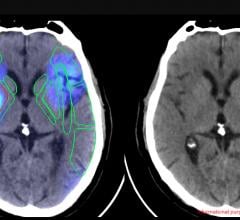February 14, 2008 - Computer-aided detection (CAD) enhanced performance of a single reader, yielding increased sensitivity with only a small increase in recall rate in a large scale breast screening trial that compares the efficacy of single reading with CAD to double reading and also to the first reader (without CAD) in a double-reading program.
The study, which was published as an online version of the American Journal of Roentgenology, the scientific journal of the American Roentgen Ray Society, which will appear in the April 2008 issue of the research journal, compared the recall rate, sensitivity, positive predictive value and cancer detection rate for single reading with CAD, versus double reading without CAD. Biopsy and pathology data for positive cases were also compared.
The author of the study, Matthew Gromet, M.D., of the Breast Imaging Section of Charlotte Radiology, ran the study at a large imaging practice in Charlotte, North Carolina. A review was performed of 231,221 screening mammograms interpreted by experienced mammographers from 2001 through 2005 in a community-based mammography program. In 112,413 (48.6 percent), mammographers performed the first of two readings. In 118,808 (51.4 percent), they performed a single reading aided by CAD.
The researchers found in their conclusion: “Double reading increased sensitivity with a modest increase in the recall rate compared with single reading. Single reading with CAD, compared with double reading, resulted in a small, but not statistically significant, increase in sensitivity with a lower recall rate. Our results indicate that CAD enhances performance of a single reader, yielding increased sensitivity with only a small increase in recall rate.”
Dr. Gromet found that a single reader with CAD had a statistically significant increase in sensitivity (11 percent) and a smaller increase in recall rate (4 percent), when compared to a single reader without CAD assistance. He also found that single reading with CAD review, when compared with independent double reading, resulted in a not statistically significant increase in sensitivity, but with a statistically significant lower recall rate. With manpower constraints limiting the use of double reading, Dr. Gromet concludes that “CAD appears to be an effective alternative that provides similar, and potentially greater, benefits.”
This study is significant in light of the skepticism surrounding CAD after an article published last year in the New England Journal of Medicine (NEJM). Authored by Joshua Fenton, M.D., MPH, Department of Family and Community Medicine, University of California, Davis, the study showed findings questioning the benefits of CAD technology. The study received national attention in spite of the fact that it used nearly 10 year-old software, and irrespective of two dozen other studies published on CAD with differing results.
In Dr. Gromet’s study, the number of CAD cases is nearly four times greater than that reported in the Fenton paper published in the NEJM last year, and the study was conducted by nine radiologists at Charlotte Radiology with a mean level of experience in mammography of 15 years.
The mammograms in Dr. Gromet's study were screen-film studies obtained on Hologic mammography equipment. The CAD technology used in the study was the Hologic R2 ImageChecker CAD system.
For more information: http://www.ajronline.org/aheadofprint/04_07_2812_WI.pdf


 June 06, 2023
June 06, 2023 








